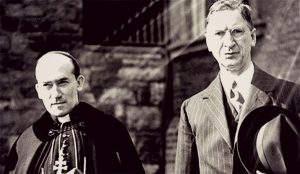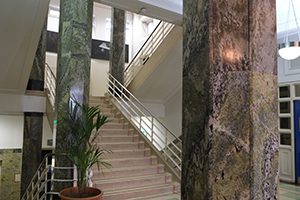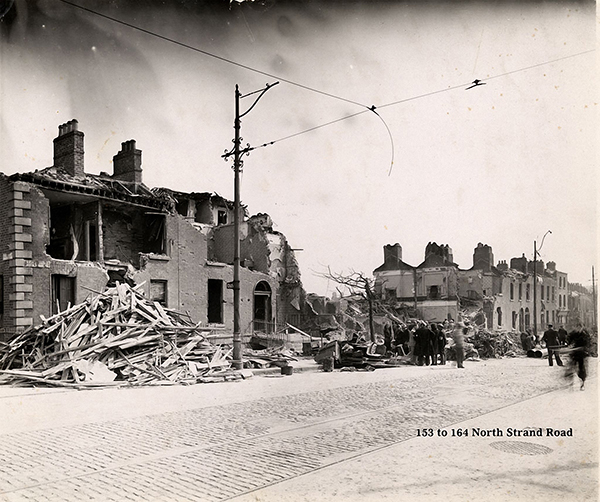75th ANNIVERSARY Happy homes and home-craft: Cathal Brugha Street College of Catering
Published in 20th Century Social Perspectives, Features, Issue 4 (July/August 2016), Volume 24‘HERE … WILL BE TRAINED THE WOMEN WHO WILL ASSIST IN BUILDING HAPPY HOMES, FOR HERE WILL BE IMPARTED RIGHT KNOWLEDGE AND PRACTICE OF HOME-CRAFT.’—ARCHBISHOP JOHN CHARLES McQUAID AT THE FORMAL OPENING OF ST MARY’S COLLEGE OF DOMESTIC SCIENCE, CATHAL BRUGHA STREET, 16JUNE 1941.
By Brian Murphy

Above: ‘Here…will be trained the women who will assist in building happy homes, for here will be imparted right knowledge and practice of home-craft’—Archbishop John Charles McQuaid (with Éamon de Valera in December 1940).
St Mary’s College opened its doors against a backdrop of national pride. Less than five weeks earlier, there had been a major state celebration of the25thanniversary of the Easter Rising. Reflecting on the aims of the Rising, Taoiseach Éamon de Valera said that ‘the social objective was to try to secure equal rights for the whole of the people’. De Valera’s comments reflected the progressive and egalitarian nature of the 1916Proclamation, which guaranteed ‘equal rights and equal opportunities to all its citizens’ and set itself the objective of ‘cherishing all the children of the nation equally’.
A deeply conservative and patriarchal society
Beyond this rhetoric, the reality of independent Ireland was of a deeply conservative and patriarchal society. Women’s lack of equality was reflected in the Conditions of Employment Act 1935, which had extended the marriage bar to all female civil servants and gave the government power to limit the number of women employed in any given industry. It was an orthodox political viewpoint that a married woman’s place was not in the workplace.
The belief that domestic work was ‘women’s work’ was deeply ingrained in Irish societal thinking. Margaret Ward has suggested that the fledgling independent state implemented,‘with little resistance, highly reactionary policies in relation to women, whose domestic role within the family became endowed with almost sacramental qualities’.At the formal opening of St Mary’s College, a quasi-theocratical allianceof McQuaid and the minister for education, Tom Derrig, touched on this theme in their official remarks.McQuaid said that the new college would provide an ‘essential element of women’s education’ and he looked forward to the day when educational accomplishment would be measured ‘not [by] the number of girls who had won a merely academic success in examinations, but by the multitude of girls whom they had trained, first to help their mothers at home and later to build for themselves a happy home’.Derrig predicted that if ‘the college exercised its influence on wise and well-considered lines, it would assist the state to maintain one of its most cherished principles—the preservation of family life’.
In 1937 de Valera enshrined women’s domestic duties in the new Irish constitution, in articles to which feminists have repeatedly objected. Article 41.2.1 recognised, in particular, that ‘by her life within the home, woman gives to the State a support without which the common good cannot be achieved’. Article 41.2.2 tasked the state with endeavouring ‘to ensure that mothers shall not be obliged by economic necessity to engage in labour to the neglect of their duties in the home’. The establishment of St Mary’s College was about helping to fulfil these constitutional imperatives and ensuring that Irish women had access to best-quality training for domestic duties. The prospectus for the new college noted that ‘the main function of the College is to offer those types of domestic science instruction which cannot be provided in the ordinary school. The building has been designed and equipped for this purpose.’
First students
In September 1941 Cathal Brugha Street received its first intake of students, and among the subjects taught were ‘art, needlework, laundry, dressmaking and dress design, housewifery, cooking (including institutional and hotel work), the training of chefs and waitresses, applied science, domestic housekeeping and physical culture’. The college’s prospectus referred to its ‘national importance’ because the new institution would be ‘responsible for the work of training teachers of Domestic Economy which was formerly carried out at St Kevin’s Park, Kilmacud’.Kathleen O’Sullivan was appointed first principal and serveduntil 1950, when she was succeeded by another woman,Winifred Bouchier-Hayes.
Though the college was predominantly associated with training women for domestic duties, a small number of other courses were offered, including in institutional management ‘for persons who wished to train for positions in schools, clubs, hospitals and similar institutions’, a course sponsored by the Department of Education in nutrition and dietetics for persons in the public health services, and a course run in conjunction with the Hotel and Restaurant Keepers’ Association for boys of fifteen or sixteen who wished to train as chefs. In far-sighted remarks when officially opening St Mary’s, Tom Derrig saw past the ravages of world war and envisaged that the college could play a major role in making Ireland a leading tourism destination. The minister said that ‘it was important that the country should resume and increase its effort to develop the tourist trade when normal conditions were restored. It was equally important that they should start now to train those people on whose skill the ultimate success of the trade would depend.’
Vocationalism
In a wider context, the college’s emergence was linked to the strong influence of vocationalism in 1930s Ireland, a factor which even impacted heavily on the constitution through the composition of Seanad Éireann. St Mary’s was established under the auspices of the City of Dublin Vocational Educational Committee (CDVEC) and the driving force behind the college’s development was Louis Ely O’Carroll, the chief executive officer of the CDVEC from 1930 to 1943. In 1936 O’Carroll chaired a committee of the board of studies of the CDVEC to formulate an ambitious strategic restructuring of the technical education system in the Dublin area, which envisaged five specialised technical institutions in the environs of the city centre. The report, Organisation and development of the scheme of technical education,noted that five technical institutes were to be designated: the College of Technology, a new building, centrally located to replace that at Kevin Street;the High School of Commerce, a new building, centrally located, to accommodate the programmes provided in the building at Rathmines;the School of Trades and Crafts, Bolton Street; the School of Domestic Science, a new building to be erected on a site at Cathal Brugha Street;and the School of Music, in new premises to replace the building at Chatham Row.
As Duff et al. note in their history of the Dublin Institute of Technology, not all aspects of this restructuring plan were delivered upon; as circumstances changed, financial realities hit home and the Emergency intervened. Nevertheless, many strands were implemented. Early priority was given to the construction of a new college at Cathal Brugha Street. On 20 July 1936, the CDVEC published an invitation for tenders ‘for building a College of Domestic Science and Women’s Work at Cathal Brugha and Marlborough Street’. The contract was ultimately awarded to H. &J. Martin, a major building and property company based in Belfast, which had previously constructed a number of landmark buildings, including Belfast’s City Hall, Belfast’s Grand Opera House and the magnificent Slieve Donard Hotel, which overlooks the world-famous Royal County Down golf-course.
Art deco
The architects were a Merrion Square-based firm, Robinson and Keeffe, which had previously designed the Dublin Gas Company on D’Olier Street, the Carlton Cinema on O’Connell Street, the Fairview Technical School and the Irish Sweepstakes building in Ballsbridge. Robinson and Keeffe specialised in art deco architecture, a popular style of visual arts design that emerged in France prior to the First World War but went into decline after the Second World War; the college in Cathal Brugha Street remains one of the best examples of art deco architecture in our capital city.
The building took over threeandahalf years to complete and was built at a cost of £100,000, which in today’s terms would equate to c. €6 million. The building has provided enduring value for money: in 2016, as part of its plans to relocate to Grangegorman, the Dublin Institute of Technology quoted a guide price in the €10–€12.5 million range for the purchase of the 1941 building on Cathal Brugha Street, not including the connected 1990s modern extension. At the time of its construction, the college in Cathal Brugha Street represented the largest capital expenditure investment in an educational project in the state’s short history. This resulted in considerable attention to detail; before plans were finally approved, the CDVEC made visits to similar institutions in London, Scotland and Sweden to ensure that it would be built ‘on the most up-to-date lines and in accordance with modern practice’. The building was constructed almost entirely from Irish materials, employing Connemara marble, Kilkenny limestone, Irish granite worked in Dublin, and Irish red bricks from Ballinphellic, Co. Cork.

Above: The building was constructed almost entirely from Irish materials, including the Connemara marble seen here in the stairwell. (Peter Griffin)
Given the shortages occasioned by wartime and the mass destruction taking place elsewhere across Europe, the completion of a brand-new state-of-the-art educational facility was seen as a real national achievement. On viewing the college, an Irish Times journalist reported that ‘all the rooms are large and bright and there is an air of dignity about the whole exterior and interior design of the college’. Just sixteen days prior to its official opening, the almost-completed college had a very lucky escape. In the early morning of 31 May 1941, German bombs fell on the North Strand, less than a mile from Cathal Brugha Street, demolishing property and causing a severe loss of life.

Above: Just sixteen days prior to its official opening, in the early morning of 31 May 1941, the almost-completed college had a very lucky escape when German bombs fell on the North Strand, less than a mile away. (Dublin City Archives)
Location and name
Cathal Brugha Street had been chosen as the location because of its ease of access. Though St Mary’s would be under the control of the City of Dublin VEC, it was open to students from every part of Ireland and a central location was deemed necessary. The CDVEC opted for Cathal Brugha Street because ‘the site selected is in a good position, near a principal thoroughfare and conveniently situated in regard to transport in all directions’. Cathal Brugha Street was a mere nine years in existence when the college opened, created in a reconstruction of city streets following the destruction of the Civil War. Originally the street had no official name, as the city corporation had been dissolved, but locals referred to it as ‘Cathal Brugha Street’, after the anti-Treaty leaderwho had been mortally wounded in the vicinity in the early days of the Civil War in July 1922. In 1932the street was officially named in Brugha’s honour by a reconstituted corporation. The new college contributed strongly to the identity of the street and has gone on to become an iconic building and a landmark location in our capital.
Social, cultural and educational mores have changed significantly in the 75 years since the college in Cathal Brugha Street first opened its doors. In its various guises—St Mary’s College, the College of Catering and latterly, since 1992, as the Dublin Institute of Technology, Cathal Brugha Street—the building has played host to tens of thousands of staff and students, male and female, from every corner of the globe and has contributed enormously to Irish education.
Dr Brian Murphy is a lecturer in the Dublin Institute of Technology.
FURTHER READING
T. Duff, J. Hegarty & M. Hussey, The story of the Dublin Institute of Technology(Dublin, 2000).
N. O’Connor (ed.), Dublin College of Catering 1941–1991(Dublin, 1991).
Read More:
The Three Graces
















